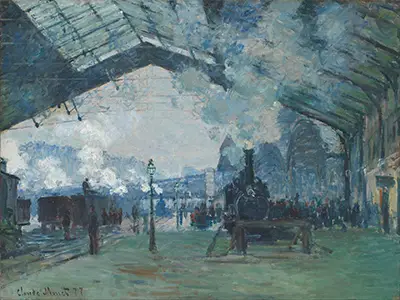Arrival of the Normandy Train, Gare Saint-Lazare
In 1877, Monet, together with his friend Gustave Caillebotte, rented an apartment near to Gare Saint-Lazare. Monet painted 12 paintings in his time here, 'Arrival of the Normandy Train' being the largest, measuring 60.3 x 80.2 cm.
The painting is largely industrial and features a steam train, billowing clouds of smoke and steam. There is a large emphasis on light and dark within the piece. At the end of the 19th Century, the railroad was quickly becoming a popular topic for many artists, but Monet was one of the few that embraced the industrialised view of the subject.
Monet's use of thick oil pigment is typical of the work that he created in this period. When under close inspection, the paint appears as gelatinous blobs and it isn't until the painting is viewed from a distance that the entire scene becomes clear. It is this technique that led to Cézanne commenting that, “Monet is only an eye, but my God what an eye!”
Monet is rumoured to have arranged for the steam trains at Gare Saint-Lazare to be stoked with extra coal so that he could scrutinise the plumes of smoke and paint their details. Monet's careful application shows the light flooding the station and is highlighted in the billowing smoke. Dark grey and menacing inside the station but fluffy and white against the blue sky. At the time, the thick industrial smog in Paris was of widespread concern and Monet's focus on the subject is considered a commentary on the interests of society.
The focus of the painting is the steam train itself which gained criticism when Monet exhibited part of the collection in 1877. Critics disliked the fact the train was the main focus and that the architecture of Paris has been obscured. The grand apartments and the Pont de l’Europe (a bridge near the station) are shrouded by the steam. Monet uses elements of blue, pink, yellow and violet, as well as traditional smoky colours to create the haze and industrial mist that hangs over the train yard, hiding the view of the buildings behind. The inclusion of the distant train yard and the large steel girders of the roof are harsh in contrast to the stereotypical view of Paris. 'Arrival of the Normandy Train' is not stylish or pretty, but an honest account of industrialised France.
Shrinking into the background, the mass of people waiting to board the train is a jumble of indistinguishable shapes. The detail and focus are clearly on the train, not on the people. This focus was pioneering; even in work of his contemporaries, paintings of city life were dominated by the subjects within them, very few, if any, made trains the central focal point of a painting as Monet did.


